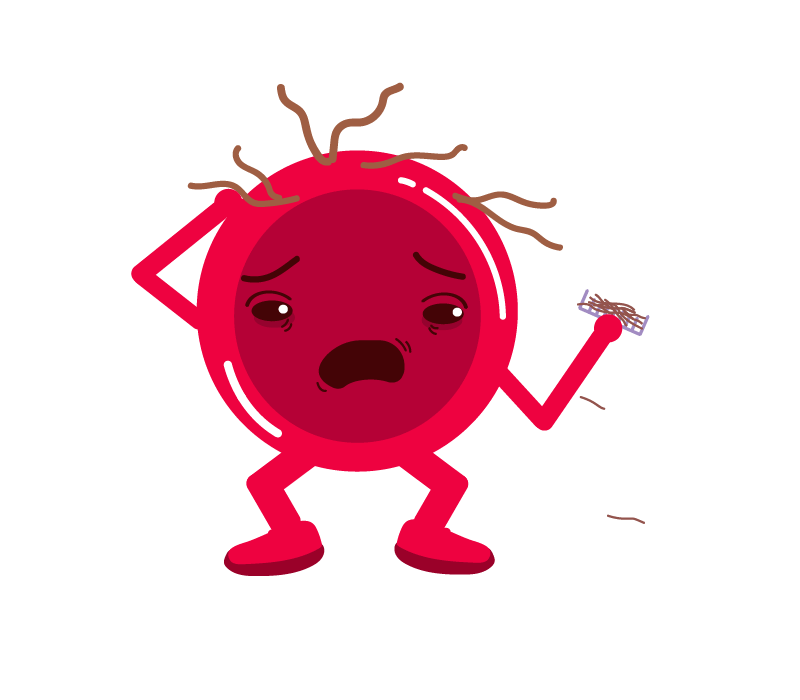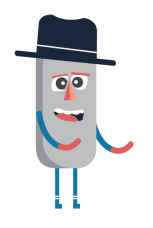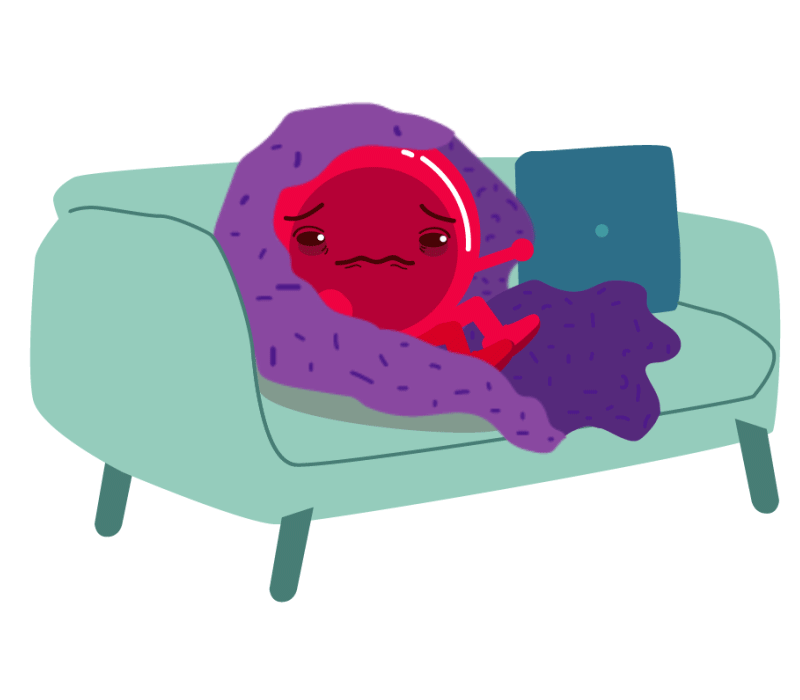Sometimes and especially in the early stages of iron deficiency there may be no symptoms and the condition can only be identified by a blood test. More commonly however there are numerous symptoms that can suggest iron deficiency. When the iron depletion progresses it is more likely that more symptoms will develop as the oxygen levels and energy generation in cells is compromised.
Tiredness and fatigue

The most common symptom that is reported to affect more than half 2 of people with iron deficiency is a feeling of low energy and physical exhaustion. Often people wake up feeling tired and sometimes need to sleep during the daytime. As a consequence, it can sometimes affect work performance and lead to stress. It is often not recognised as abnormal because it is often attributed to a normal part of daily life, ageing or stress.
This is such a crucial symptom which directly affects the quality of life6 that when you attend WA Iron Centre we will ask you to complete a questionnaire before and after treatment to ascertain the benefit of treatment
Mouth ulcers

The occurrence of a sore mouth associated with white patches on the lining of the mouth could indicate ulceration. These mouth ulcers often recur and can be quite painful. It is thought to occur because of a diminished immune system associated with a dryness of the lining of the mouth 7.
Hair loss

A common symptom, particularly amongst women, is the loss of hair often in clumps. Losing small amounts of hair in itself is not abnormal but when iron deficient the hair cells are deprived of oxygen and become brittle and fall out easily.
Bruising

Bruises tend to occur with trivial injury and take longer to recover. The exact mechanism whereby iron deficiency causes this is not certain and requires more research.
Headache

Recurrent headaches are frequently reported with iron deficiency however the mechanism by which this occurs is not well understood and requires a lot more research.
Paleness

A symptom that is often noticed by others is a paleness of the skin. Blood is red because of its haemoglobin concentration and when this is diminished from iron deficiency the skin can look pale. Similarly, the lining of the inside of the eye (conjunctiva) and mouth could also look pale. This is why doctors may pull the lower lid down to inspect the lining inside of your eye to see whether there is evidence of what they call ‘pallor’. Paleness however is a sign of anaemia and indicates that iron deficiency is quite severe.
Brittle nails

The growth of nails are due to several vitamins and minerals including iron. When iron deficient nails tend to become brittle and crack easily8.
Cold Intolerance

A change in the tolerance to temperature particularly cold extremities affecting the fingertips and toes. It is thought this occurs because of lower oxygen levels in the circulation and the impairment of the bodies thermoregulatory system 9.
Restless leg

In this condition there is an abnormal sensation (mostly in the legs) that is relieved by movement. Consequently, there is a need to move the legs constantly particularly at night. When it is severe it can affect sleep and quality of life. There are many causes of restless leg syndrome but iron deficiency is a common association 10.
Craving for ice

The medical term for this is ‘Pica Syndrome’ where there is an insatiable appetite for ice but can also occur with other non-food items such as clay or dirt. It is thought to be because of a disturbance of neurological pathways but the exact metabolic basis is not fully understood 11.
Infections

The occurrence of more infections than usual which take longer to resolve could be an indicator of iron deficiency. Iron is an integral part of the immune system but how this actually manifests is quite complicated and still not properly understood 12.
Shortness of breath, palpitations and dizziness

When the iron deficiency is more severe and anaemia occur, the body needs to get more oxygen. The lungs and heart have to work harder to deliver more oxygen to the tissues. In the early stages there is a noticeable decline in exercise capacity and normal activities such as walking and climbing stairs are more difficult. The anamia can cause the blood pressure to drop leading to dizziness.
Cracks at the corner of the mouth
A medical condition called Angular Cheilitis occurs with iron deficiency where there is soreness with cracks at the corners of the mouth with crusts that do not heal.
Soreness of tongue and dry mouth
A red, swollen and smooth surface of the tongue is seen in more severe iron deficiency. These changes are from the lack of oxygen to the tongue and reduced myoglobin. The mouth also tends to be dry leading to a frequent need to drink13.
Irritability, low mood

Persons with iron deficiency sometimes report that they are more anxious, get frustrated and angry easily or are overly sensitive. This can progress to a low mood and depression. The neurological effects of iron deficiency awaits further research.
Poor concentration and attention

An area that is receiving more research attention recently, especially in children, is a lack of concentration and associated ADHD-like symptoms.
Initially, iron deficiency anaemia may go unnoticed, but as your body becomes more iron deficient the symptoms can intensify. Iron deficiency is primarily a women’s health issue that can impact a person’s quality of life, family and community connections, complications for other illnesses, as well as economically.
References
2. Miller, J. Iron Deficiency Anaemia – A common and curable condition. Cold Spring Harb Perspect Med 2013;3:a011866
6. Patterson AJ, et al. Iron deficiency, general health and fatigue: Results from the Australian Longitudinal Study on Women’s Health. Quality of Life Research. 2000; 9: 491-497.
7. Scully C. ABC of oral health: Mouth ulcers and other causes of orofacial soreness and pain. BMJ. 2000; 321(7254): 162-165.
8. Cashman MW Sloan SB. Nutrition and nail disease. Clinics in Dermatology. 2010; 28: 420–425
9. Rosenzweig PH, Volpe SL. Iron, thermoregulation, and metabolic rate.Crit Rev Food Sci Nutr. 1999 Mar;39(2):131-48.
10. Wang J et al. Efficacy of oral iron in patients with restless legs syndrome and a low-normal ferritin: A randomized, double-blind, placebo-controlled study Sleep Med. 2009 Oct;10(9):973-5.
11. Lacey EP. Broadening the perspective of pica: literature review. Public Health Rep. 1990; 105(1): 29-35.
12. Dhur A, et al. Comparative Biochemistry and Physiology Part A: Physiology Volume 94, Issue 1, 1989, Pages 11–19.
13. Osaki T, et al. The pathophysiology of glossal pain in patients with iron deficiency and anemia. Am J Med Sci. 1999; 318(5): 324-9.
We would like to thank Vifor for allowing us to use some of their animations.
